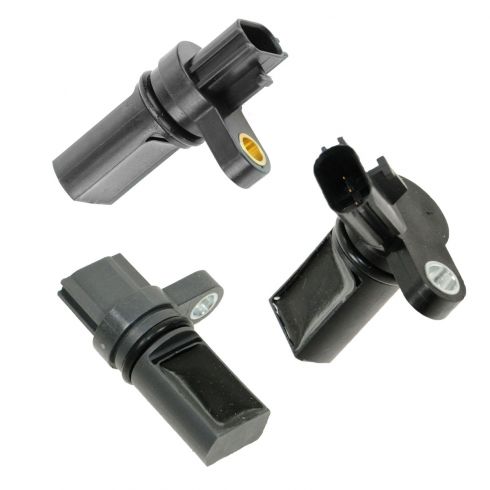Is That Rattling Your Engine a Bad Timing Chain Tensioner? Here’s What You Need to Know
Your car’s engine relies on a complex dance between various components to run smoothly and efficiently. One crucial player in this synchronized performance is the timing chain tensioner.
The Maestro of Engine Timing:
Imagine the engine’s crankshaft, like a conductor’s baton, keeping rhythm. This powerful shaft spins in time, transferring power from the pistons. But the real magic happens through the camshaft, which needs to open and close the engine’s valves at precisely the right moments. This is where the timing chain comes in. It acts like a synchronized belt, connecting the crankshaft to the camshaft, ensuring they operate in perfect harmony.
The Guardian of Harmony – The Timing Chain Tensioner:
But a chain left to its own devices can become loose or slack over time. This is where the timing chain tensioner steps in. It acts as a vigilant guardian, constantly applying the right amount of pressure to keep the timing chain taut. This ensures the camshaft receives the crankshaft’s signal precisely when needed, allowing the valves to open and close at the exact moments for optimal engine performance.
The Peril of a Faulty Tensioner:
Unfortunately, a worn-out or malfunctioning timing chain tensioner can throw this delicate dance into disarray. A loose timing chain can cause the camshaft to be slightly out of sync, leading to a cascade of problems. In the worst-case scenario, a completely failed tensioner can lead to a situation where the timing chain jumps teeth on the sprockets, causing catastrophic engine damage and potentially even valve failure.
Warning Signs: How to Spot a Failing Timing Chain Tensioner
A healthy engine purrs along with a satisfying hum. But if a discordant rattle disrupts the symphony, it might be time to investigate your timing chain tensioner. Here are the telltale signs that this crucial component might be failing:
The Rattling Revelry:
One of the most common symptoms of a bad timing chain tensioner is an unusual rattling noise coming from the engine. This rattling is often most noticeable during startup, when the oil pressure hasn’t yet fully built up to take up the slack in the timing chain. As the engine warms and the oil circulates, the noise may become less prominent, but it’s a warning sign that shouldn’t be ignored.
Rough Idling and Performance Woes:
A failing timing chain tensioner can disrupt the precise timing of the valve opening and closing. This can lead to rough idling, where the engine shakes and vibrates abnormally. You might also experience a noticeable loss of power and sluggish acceleration as the engine struggles to perform efficiently.
The Illuminated Check Engine Light (CEL):
The check engine light (CEL) is your car’s way of communicating potential problems. While it doesn’t pinpoint the exact issue, a lit CEL in conjunction with the other symptoms mentioned above can be a strong indicator of timing chain tensioner trouble.
We’ll delve deeper into the causes of a bad timing chain tensioner in the next section, but for now, let’s address some potential culprits:
Casuistic Culprits:
Several factors can contribute to a failing timing chain tensioner:
- Worn Timing Chain: Over time, the timing chain itself can stretch or wear due to age and mileage. This increases the slack that the tensioner needs to manage.
- Low Engine Oil Level or Dirty Oil: Engine oil plays a vital role in lubricating the timing chain tensioner and keeping it functioning properly. Low oil levels or dirty oil can hinder its ability to maintain proper tension.
- Faulty Hydraulic Tensioner: Most timing chain tensioners are hydraulic, relying on oil pressure to function. A malfunction in the internal mechanism of the tensioner can render it ineffective. (This is the most common cause of tensioner failure.)
- Broken Tensioner Spring: While less frequent, the tensioner spring can also break, causing a complete loss of tension on the timing chain.
Unveiling the Culprits: Why Your Timing Chain Tensioner Might Be Failing
In the previous section, we explored the warning signs of a failing timing chain tensioner. Now, let’s delve deeper and understand the root causes of this potential engine malady.
The Usual Suspects:
- Worn Timing Chain: As your car ages and racks up miles, the timing chain itself can become a culprit. Just like any metal component, it can stretch or wear out over time. This increased slack puts extra strain on the tensioner, making it harder to maintain proper tension.
- Low Engine Oil Level or Dirty Oil: Engine oil is the lifeblood of your engine, and it plays a critical role in keeping the timing chain tensioner functioning properly. If the oil level is low, there’s not enough lubrication to ensure smooth operation of the tensioner. Dirty oil, clogged with contaminants, can also hinder its ability to maintain proper pressure.
- Faulty Hydraulic Tensioner (The Most Common Culprit): Most timing chain tensioners are hydraulic in nature. They rely on oil pressure to push a piston within the tensioner, which in turn applies pressure to the timing chain. If the internal mechanism of the tensioner malfunctions, it may not be able to generate enough pressure or maintain consistent tension, leading to a loose timing chain.
- Broken Tensioner Spring (A Less Frequent Offender): While less common, the tensioner spring can also break. This spring provides the base level of tension before oil pressure takes over. A broken spring essentially renders the tensioner ineffective, allowing the timing chain to become dangerously loose.
Why You Need a Professional Diagnosis:
Diagnosing a failing timing chain tensioner can be tricky. While the symptoms we discussed earlier can offer clues, a professional mechanic is best equipped to pinpoint the exact cause. They can perform a visual inspection to check for a loose timing chain and use a mechanic’s stethoscope to isolate the source of the rattling noise. Additionally, they may have access to specialized diagnostic tools to confirm the issue.
The Importance of Listening In:
A mechanic’s stethoscope is a valuable tool for diagnosing timing chain tensioner problems. By placing the stethoscope on specific points around the engine, a mechanic can isolate the source of the noise and determine if it’s originating from the timing chain area. This targeted listening approach helps pinpoint the culprit and ensures a more accurate diagnosis.
In the next section, we’ll explore the risks of ignoring a bad timing chain tensioner and the steps involved in repairing it.
Untangling the Trouble: How Mechanics Diagnose a Failing Timing Chain Tensioner
The telltale signs of a failing timing chain tensioner can be concerning, but don’t panic. While a professional diagnosis is crucial, there are ways mechanics shed light on the issue.
Why DIY Diagnosis Might Not Be Wise:
While some car enthusiasts might be tempted to tackle a timing chain tensioner replacement themselves, it’s important to remember that diagnosing the problem accurately is just as important as the repair itself. A misdiagnosis can lead you down the wrong repair path, wasting time and money. Mechanics have the training, experience, and specialized tools to effectively diagnose a failing timing chain tensioner.
The Art of Inspection:
A skilled mechanic can gain valuable insights through a visual inspection. This might involve removing certain engine components to get a clear view of the timing chain. They’ll be looking for signs of a loose timing chain, which can indicate a failing tensioner.
The Power of Listening:
A mechanic’s stethoscope becomes a detective’s magnifying glass in this case. By strategically placing the stethoscope on different parts of the engine, the mechanic can pinpoint the source of the rattling noise. If the noise originates from the timing chain area, it strengthens the suspicion of a failing tensioner.
The Looming Consequences of Ignoring the Issue:
Ignoring the warning signs of a bad timing chain tensioner can lead to a cascade of problems down the road. Here’s why it’s crucial to address this issue promptly:
- Engine Timing Issues and Performance Problems: A loose timing chain throws off the precise timing of the valve opening and closing. This disrupts the engine’s combustion process, leading to performance issues like rough idling, decreased power, and potentially increased fuel consumption.
- Potential for Valve Damage and Engine Failure (Brace Yourself for Expensive Repairs): In the worst-case scenario, a completely failed timing chain tensioner can allow the timing chain to jump teeth on the sprockets. This can cause the valves to collide with the pistons, leading to catastrophic engine damage. The repairs for such extensive damage can be very expensive, potentially even requiring engine replacement.
In the next section, we’ll explore how to fix a failing timing chain tensioner and the costs associated with the repair.
The Price of Neglect: Consequences of Ignoring a Bad Timing Chain Tensioner
The warning signs of a failing timing chain tensioner shouldn’t be taken lightly. Ignoring this issue can lead to a domino effect of problems within your engine, resulting in costly repairs.
A Detuned Performance:
A loose timing chain throws a wrench into the engine’s carefully choreographed dance of pistons, valves, and fuel combustion. This disrupts the precise timing of valve opening and closing, leading to a decline in engine performance. You might experience:
- Rough idling: The engine shakes and vibrates abnormally at idle speed.
- Loss of power: The car feels sluggish and struggles to accelerate.
- Potential for increased fuel consumption: Engine inefficiency due to improper timing can lead to lower gas mileage.
The Worst-Case Scenario: Engine Failure and Broken Hearts (and Wallets):
In the most critical situation, a completely failed timing chain tensioner can allow the timing chain to jump teeth on the sprockets. This can cause a nightmarish scenario where the valves collide with the pistons. The resulting damage can be catastrophic, potentially bending valves, damaging pistons, and even causing cracks in the engine block. Needless to say, repairs for such extensive damage can be extremely expensive, sometimes even requiring a complete engine replacement.
The high cost of fixing a neglected timing chain tensioner issue highlights the importance of addressing the problem promptly at the first signs of trouble.
Restoring Rhythm: Repairing a Bad Timing Chain Tensioner
The good news is that a failing timing chain tensioner can be repaired, and addressing the issue promptly can prevent further engine damage and costly consequences.
The Fix:
Replacing a bad timing chain tensioner is a process that typically involves replacing the timing chain itself as well. The timing chain and tensioner work hand-in-hand, and if the chain is stretched or worn, it’s best to replace both components simultaneously to ensure optimal performance and longevity.
Precision Matters: Using High-Quality Parts and Following Proper Procedures:
This repair is not a DIY project for the average car owner. The timing system is a critical part of the engine, and precise timing is essential for proper engine function. Using high-quality parts is crucial to ensure long-lasting repairs. Additionally, following the proper repair procedures outlined in a repair manual specific to your vehicle’s make and model is essential. These manuals detail the specific steps involved in disassembly, replacement, and reassembly, ensuring everything is put back together correctly and the timing is set precisely.
Considering the Cost:
The cost of repairing a bad timing chain tensioner can vary depending on several factors, including:
- Vehicle Make and Model: Different vehicles have varying complexities in their timing chain systems. Luxury or high-performance vehicles might have more expensive parts and labor costs.
- Labor Rates: The hourly labor rate charged by the mechanic will impact the overall repair cost.
- Parts Quality: Opting for high-quality timing chain and tensioner components might add to the cost, but it’s a wise investment for long-term engine health.
With these factors in mind, the typical cost for repairing a timing chain tensioner can range anywhere from $500 to $1500. While it’s a significant expense, it pales in comparison to the potential cost of a neglected issue leading to engine failure.
Preventing the Rattle: Keeping Your Timing Chain Tensioner Healthy
A failing timing chain tensioner can be a costly headache. The good news is that preventive measures can significantly reduce the risk of encountering this issue. Here’s how to keep your timing chain tensioner happy and your engine running smoothly:
Oil is the Elixir of Life:
Regular oil changes are paramount for engine health, and the timing chain tensioner is no exception. Fresh oil ensures proper lubrication of the tensioner mechanism, allowing it to function smoothly and maintain proper tension on the timing chain.
Choosing the Right Oil:
Don’t just pick any oil off the shelf. Consult your vehicle’s owner’s manual to determine the recommended oil type and viscosity for your car. The proper oil weight ensures optimal lubrication for all engine components, including the timing chain tensioner.
Don’t Skimp on the Filter:
The oil filter plays a vital role in trapping contaminants and debris that could harm the engine. Using a high-quality oil filter ensures your engine gets clean, filtered oil, which is essential for the smooth operation of the timing chain tensioner.
Preventative Maintenance is Key:
Following your car’s recommended maintenance schedule is a wise investment. These schedules often include inspections of the timing chain and tensioner at specific mileage intervals. Addressing any minor issues early on can prevent them from snowballing into major problems down the road.
By following these simple preventative measures, you can significantly reduce the risk of a failing timing chain tensioner and keep your engine running smoothly for miles to come.
FAQ:
Here are ten frequently asked questions about the sound of a bad timing chain tensioner:
- What does a bad timing chain tensioner sound like?
The most common sound associated with a bad timing chain tensioner is a rattling noise coming from the engine. This rattling is often most noticeable during startup when the oil pressure hasn’t yet built up to take up the slack in the timing chain. As the engine warms and the oil circulates, the noise may become less prominent, but it’s a warning sign that shouldn’t be ignored.
- Can other engine problems cause a similar sound?
Yes, other engine issues can mimic the rattling sound of a bad timing chain tensioner. Loose engine components, problems with the valve train, or even issues with the exhaust system can sometimes produce similar noises. However, a mechanic can use tools like a stethoscope to pinpoint the exact source of the rattle.
- Should I drive my car if it has a timing chain tensioner rattle?
It’s not recommended to continue driving your car if you suspect a bad timing chain tensioner. While you might be able to manage for a short distance in an emergency, a failing tensioner can cause further damage to your engine. The potential consequences, like valve damage or engine failure, can be much more expensive to repair than addressing the tensioner issue promptly.
- How urgent is it to fix a bad timing chain tensioner?
A bad timing chain tensioner is a serious issue that should be addressed as soon as possible. Ignoring the problem can lead to a cascade of problems within the engine, resulting in expensive repairs. Early detection and repair are key to avoiding significant engine damage.
- What happens if I ignore a bad timing chain tensioner for a long time?
In the worst-case scenario, a completely failed timing chain tensioner can allow the timing chain to jump teeth on the sprockets. This can cause the valves to collide with the pistons, leading to catastrophic engine damage. The repairs for such extensive damage can be very expensive, potentially even requiring engine replacement.
- Is the timing chain tensioner noise always loud and noticeable?
Not always. In the early stages of failure, the rattling noise from a bad timing chain tensioner might be subtle. However, it’s important to be attentive to any changes in your engine’s sound, especially during startup. If you suspect something is off, it’s best to have a mechanic check it out.
- Are there any other symptoms of a bad timing chain tensioner besides noise?
Yes, there are other signs to watch out for:
- Rough idling: The engine shakes and vibrates abnormally at idle speed.
- Loss of power: The car feels sluggish and struggles to accelerate.
- Check engine light: An illuminated check engine light can be a warning sign of various issues, including timing chain tensioner problems.
- Decreased fuel efficiency: Engine inefficiency due to improper timing can lead to lower gas mileage.
- How much does it cost to replace a timing chain tensioner?
The cost of repairing a bad timing chain tensioner can vary depending on several factors, including vehicle make and model, labor rates, and the quality of parts used. Typically, it ranges from $500 to $1500.
- Can I replace a timing chain tensioner myself?
Replacing a timing chain tensioner is a complex repair that requires specific knowledge and tools. It’s generally not recommended for DIY unless you’re a highly skilled mechanic. The timing system is critical for engine function, and improper installation can lead to even bigger problems.
- How can I prevent timing chain tensioner problems?
The best way to prevent timing chain tensioner issues is through regular maintenance. Here are some key practices:
- Regular oil changes: Fresh oil ensures proper lubrication of the tensioner mechanism.
- Use the recommended oil type and viscosity: Consult your owner’s manual for the right oil for your car.
- High-quality oil filters: A good filter traps contaminants that could harm the tensioner.
- Follow recommended maintenance schedules: These schedules often include inspections of the timing chain and tensioner at specific mileage intervals.
Conclusion: Keeping Your Engine in Harmony – The Importance of a Healthy Timing Chain Tensioner
The timing chain tensioner plays a critical role in maintaining the synchronized performance of your car’s engine. A failing tensioner can disrupt this delicate dance, leading to a range of problems and potentially even engine failure.
The Takeaway:
- By understanding the warning signs of a bad timing chain tensioner, such as rattling noises, rough idling, and the check engine light coming on, you can address the issue promptly.
- Ignoring these signs can lead to expensive repairs down the road.
- Regular oil changes with the recommended oil type and viscosity, using high-quality oil filters, and following proper maintenance schedules can significantly reduce the risk of encountering timing chain tensioner problems.
Addressing Your Questions:
- Can I drive with a bad timing chain tensioner? It’s not recommended. While you might be able to limp the car for a short distance in an emergency, continuing to drive with a failing tensioner risks further damage to your engine. The potential consequences, like valve damage or engine failure, can be much more expensive to repair than addressing the tensioner issue promptly.
- How long does it take to replace a timing chain tensioner? The time it takes to replace a timing chain tensioner can vary depending on the vehicle’s make and model. In general, it’s a complex repair that typically takes a mechanic a few hours to complete.
- What are some other symptoms of a bad timing chain? In addition to the ones mentioned earlier, other signs of a failing timing chain can include engine misfires and decreased fuel efficiency. These occur because the disrupted valve timing throws off the engine’s combustion process.
By being proactive and attentive to your car’s health, you can ensure your timing chain tensioner keeps your engine running smoothly for years to come. If you suspect a problem, don’t hesitate to schedule a visit with a qualified mechanic. Remember, early detection is key to avoiding costly repairs.




